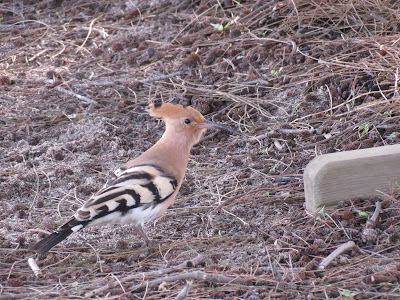I posted this picture in my previous post about parasitic plants, but I'll include it here too. This is a Spotted Coralroot (Corallorhiza maculata), a common orchid of Algonquin forests.
The rattlesnake plantains (Goodyera) are a small group of orchids found in coniferous forests, with two common species in Algonquin.
This is Dwarf Rattlesnake Plantain (G. repens). I showed the leaves in my last post, but only later got photos of the flowers.
This aberrant Dwarf Rattlesnake Plantain is missing the pale cross-hatching that most individuals have on their leaves.
Tesselated Rattlesnake Plantain (G. tesselata) is similar but larger.
I found this rattlesnake plantain in somewhat atypical habitat: a roadside in pure deciduous forest. I think it is a Tesselated but it may be a hybrid with Dwarf.
One of my favourite orchids of those I have encountered so far is Ragged Fringed Orchid (Platanthera lacera). Not particularly common in Algonquin, a population of this species has persisted in the same roadside ditch for decades.
The next two species were actually seen outside of Algonquin Park, but both can be found in similar habitat (sandy riverbanks) in the park. Small Purple-fringed Orchid (Platanthera psycodes) is a gorgeous and obvious flower.
Tubercled Orchid (Platanthera flava) is much harder to find and very unassuming!
Club-spur Orchid (Platanthera clavellata) is a common species of various boggy areas including roadside ditches. I found this plant without flowers and checked on it nearly every day waiting for all the flowers to open.
Rose Pogonia (Pogonia ophioglossoides) was somewhat more surprising to encounter in a ditch, although it is reasonably common in bogs.
Green Adder's Mouth (Malaxis unifolia) is a tiny and subtly beautiful orchid under 10 cm tall.
Platanthera orbiculata has been split into two species: P. orbiculata and P. macrophylla. Why the rules of binomial nomenclature insist that one of the species retains the name of the lumped species is beyond me, as it causes huge amounts of confusion. It is usually not a problem in groups like birds or dragonflies that have standardised common names (at least in North America), but for some reason botanists have never done so for plants. As a result, the three orchid books and one comprehensive flora I own call P. orbiculata sensu stricto (i.e. the narrow, split definition of this name) Large Round-leaved Orchid, Pad-leaved Orchis, Round-leaved Orchid, and Round Leaf Orchid, while P. macrophylla is called Greater Round-leaved Orchid, Goldie's Pad-leaved Orchis, Large Round Leaved Orchid, Large Round-leaved Orchid, and, coming out of left field, Dinner Plate Orchid. Note that the same name is used for both species, and that one book manages to use two names for the same species! I better not buy any more books to avoid any further confusion.
Anyways, the species themselves are not easy to separate, and I have found many conflicting reports on how to distinguish them. Nevertheless, I believe that the first two photos refer to P. macrophylla i.e. the larger one of the two, with the second two referring to P. orbiculata sensu stricto i.e. the smaller one of the two. I'm certainly not confident though!
Broad-leaved Helleborine is Ontario's only widespread non-native orchid, found in a variety of habitats, mostly ones with at least some disturbance.
Most orchid flowers undergo a rotation as they grow, ending up inverted 180 degrees. This photo gives some indication of what cues control this. This Helleborine had a very heavy spike of flowers, and ended up bending over under the weight. The flowers on top still ended up facing up, indicating that something like gravity or light controls the rotation, and it is not just rotating 180 degrees from the orientation of the stem.
The ladies' tresses (Spiranthes) are a large group of orchids found mostly in open areas, generally thriving shortly after clearing. Slender Ladies' Tresses (S. lacera) thrives in very dry barren areas in Algonquin Park.
Nodding Ladies' Tresses (S. cernua) is a very common species that prefers somewhat damper habitats, often being found in ditches.
And that's it! I have posted photos on this blog of every orchid I found in Ontario this year that I was able to identify. Hopefully more to come next year! I say every one I was able to identify, as there were several I wasn't. I'll leave off with this one from Northwestern Ontario. It is one of Platanthera aquilonis, dilatata or huronensis, but is probably not identifiable after the flowers are gone.


























































